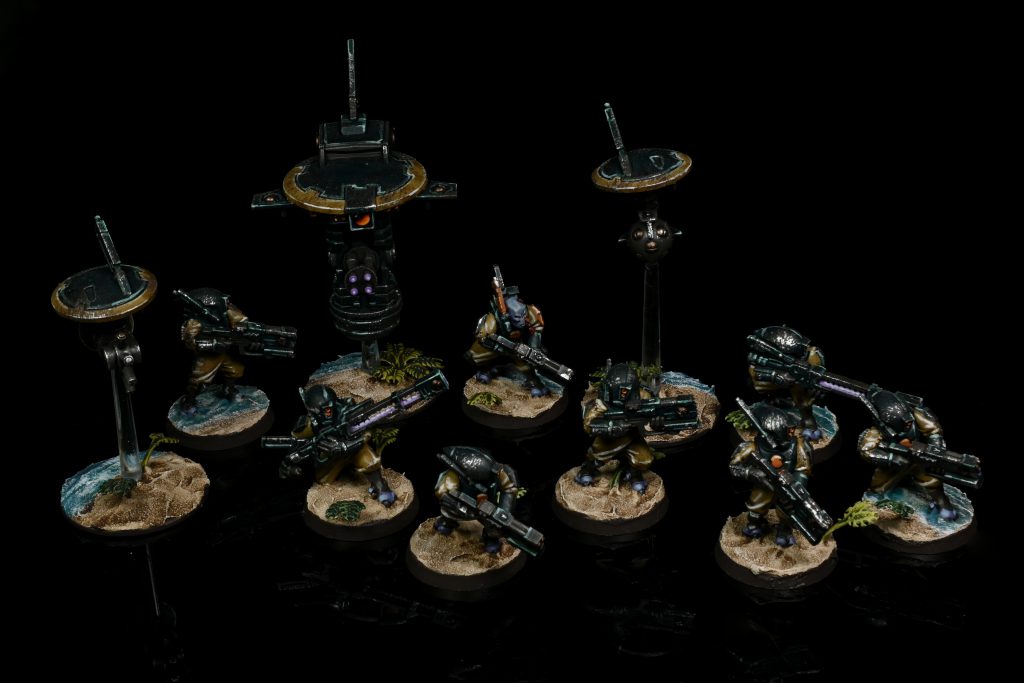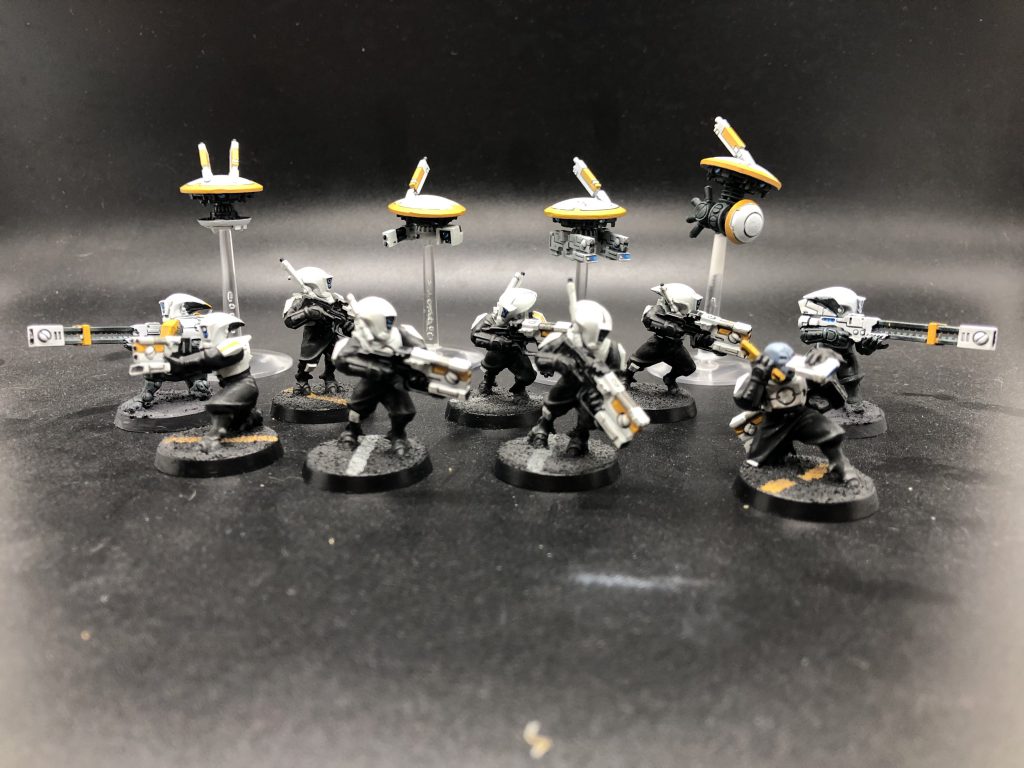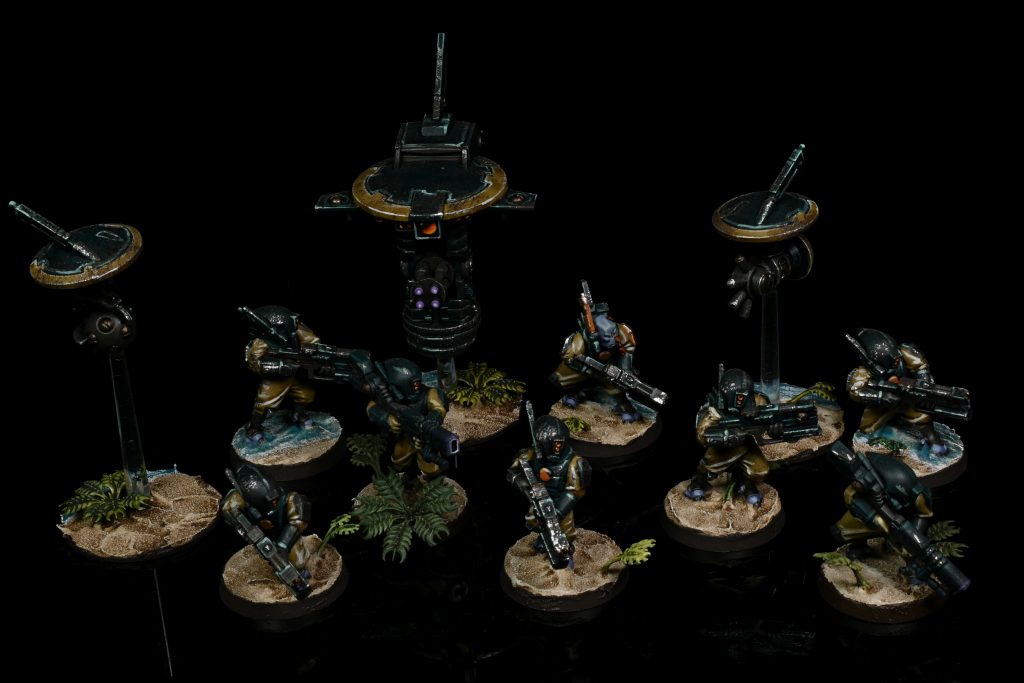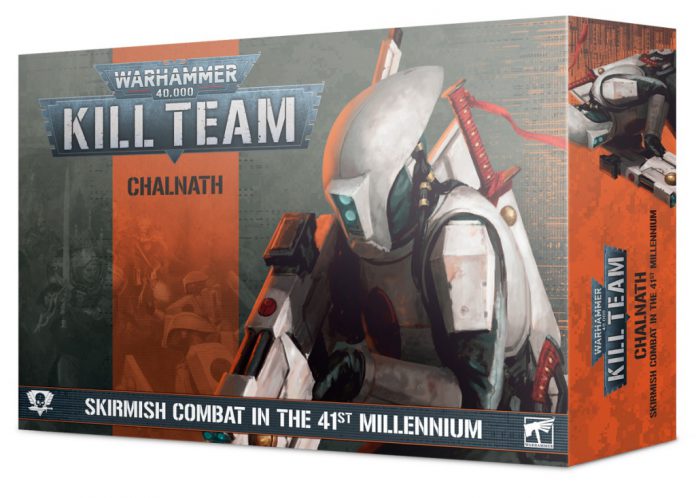Kill Team Chalnath gives us two brand-new kill teams, and while the Sisters kill team is made of all-new models, the T’au kill team continues the trend we’ve seen in recent issues of White Dwarf, giving us an updated, more focused kill team using existing models. As with those teams, Pathfinder kill teams sacrifice much of their flexibility from the Compendium for raw power, custom Tac Ops, and their own rules for Spec Ops.
So are these new, expanded Pathfinder Kill Teams ultimately the Greatest Good for T’au players, or does the loss of Stealth Suits and Fire Warriors leave them wanting? Join us as we go through the rules and find out.
Before we dive in, we’d like to thank Games Workshop for sending us a preview copy of the Kill Team Chalnath boxed set, which included these rules and models for the Pathfinders kill team.

Pathfinder Kill Teams
Pathfinder Kill Teams are made up of one Pathfinder Shas’Ui and 12 operatives chosen from a list of 15 possible choices and of those, some can be taken twice. Shas’la pathfinders are your regular yabbos, able to be picked up to twelve times, and you can have up to two Weapons Experts, who come with either an ion rifle or rail rilfe, and the rest are one-per team. You also have the option of six different types of drone – gun, shield, marker, grav-inhibitor, pulse accelerator, and recon, the last of which takes up two of your slots. We’ll come back to these operatives in a bit.
Markerlights
If you thought the mechanics for markerlights in the Compendium was too simple well, you’re in luck. Pathfinder Kill Teams have their own version of markerlights, which cares about the number of markerlight tokens on an enemy Operative. Enemies still get Markerlight tokens the same way – you spend 1 AP to put a Markerlight token on an enemy operative and can only shoot that operative if you opt to shoot something – but now Operatives lose one Markerlight token each Initiative phase.
Similar to 40k, there are five possible effects for Markerlight tokens. Having 1+ still gives you the ability to re-roll one of your attack dice, but having 2+ gives your ranged weapons the No Cover special rule, 3+ improves your Ballistic skill, 4+ lets you ignore Obscured, and at 5+ you can ignore Conceal orders. This is an incredibly nasty set of progressive effects, but actually putting 5 on an opponent will mean skipping a lot of movement and/or shooting. Fortunately there are a couple of ways to bypass this.
Art of War
Similar to the Orders Veteran Guardsmen get, T’au take a page from Sun T’zu with their Art of War rules, which give them the ability to once per game have the team’s Shas’ui declare either Mont’ka or Kauyon during the Strategic Ploys phase.
- Mont’ka gives every operative with an Engage order a free Dash move
- Kauyon lets you retain an additional dice for your Cover bonus when rolling defence
These are neat abilities, and of the two Mont’ka is likely the more valuable, giving your whole team free extra movement to get into position, drop a Markerlight, and shoot a target. Kauyon requires operatives in cover to really give you value and is much more situational.

The Operatives
There are new and returning treats here. the Shas’La Pathfinder – the basic team member from the Compendium – is reprinted here, and the Weapons Expert Pathfinder is identical to the Heavy Gunner from the Compendium. Likewise, Gun Drones, Grav-Inhibitor Drones, Shield Drones, and Pulse-Accelerator Drones are also unchanged here. So let’s focus on what’s new and different.
- Shas’Ui Pathfinders are the leaders of Pathfinder kill teams, and the only model to get the Art of War ability to call a Mont’ka or Kauyon once per game. They carry the same Pulse Carbine as before, but trade out their gun butt for a Bonding Knife, a significantly improved melee option that hits on a 4+, and does 3/4 damage with the Balanced trait. They also pick up the Holographic Readout ability, which once per battle gives a non-drone operative within ■ the ability to perform a mission action for one less AP.
- Blooded Pathfinders are just regular Pathfinders but come with a Bionic Arm and a Suppressed Pulse carbine rifle. They get a better melee profile (4+, 4/5 damage) and Silent on their carbines, making them incredibly handy operatives since they can keep Conceal orders up all game and aren’t completely worthless fighters in a pinch.
- Drone Controller Pathfinders are essential to any team running heavy drone support. Their Drone Scout ability lets them deploy a single drone outside of your drop zone (and the opponent’s), and their Control Drone unique action lets you spend 1 AP to either immediately activate a drone and cause it to lose some of its AI rules (letting it take cover, getting +1 APL, and letting it move objectives), or alternatively perform a free Dash or Shoot action if you’ve already activated the drone.
- Transpectral Interference Pathfinders come with special sensors that allow them to treat enemy targets as not Obscured, and they come with the System Jam action that lets them reduce the APL of a visible enemy operative by 1.
- Assault Grenadier Pathfinders make good use of the new Pathfinder upgrade sprue and come with EMP, fusion, and photon grenades for free. They can lob each grenade twice instead of once and their special helmet lets them ignore any modifiers to APL, WS, and BS when they make attacks. Fusion grenades are the real prize here, a nasty attack that does 3 mortal wounds on a crit, though EMP grenades are also pretty nasty.
- Communications Specialists can boost the APL of nearby operative.
- Medical Technicians can revive nearby operatives, picking them back up with 1 wound and giving them a free Dash action. They can also use their Medikits to heal lost wounds on friendly operatives.
- Marksman Pathfinders give you an additional rail rifle; they come with a special Marksman Rail Rifle that hits on a 3+ and can either fire the standard rounds or Dart Rounds, which trade Lethal 5+ for Silent, turning them into deadly snipers. Their Inertial Dampener ability lets them make Overwatch shots at full BS.
- Recon Drones return with their Analyse action but pick up the Recon Suite ability, which lets you resolve a free additional Recon option during the Scouting step.
- Marker Drones in Pathfinder teams have the High-intensity Markerlight ability, which drops 2 markerlights on an enemy operative instead of 1 when you mark them. This makes them one of the most valuable operatives in the team.
On the whole, Pathfinder teams don’t pack quite the offensive punch of Hunter Cadre Kill Teams – the raw output of Stealth Suits is hard to match – but they make up for that by being much stealthier and more versatile. They’re also going to depend much more heavily on markerlights, aiming to get 3+ on a target whenever possible to ensure they’re hitting on 3+ and re-rolling misses.
Ploys
Similar to what we’ve seen for other team updates, Pathfinder teams get some new ploys and some returning ones.
Strategic Ploys
Recon Sweep returns here but with no Fire Warriors or Stealth suits, the other three are all-new. Take Cover gives your Pathfinders +1 to their saves if they’re in cover for a turn, while Bonded gives you a shooting attack re-roll if you’re near another friendly operative. And Determined Tactican can be used if you still have a Shas’Ui on the table to extend your Mont’ka/Kauyon one more turn.
These are all OK, and Take Cover is likely to be one you use early and often to protect your Pathfinders as they get close. Bonded is interesting, and while it stacks with Markerlights, its utility is largely going to be limited to when you don’t have markerlights up, since re-rolling a single attack dice is the bonus you get for only having one.
Tactical Ploys
Supporting Fire returns here but the other two are new. A Worthy Cause is used at the start of the Firefight phase to activate first in a round so long as it’s near an objective or an enemy operative. This is incredibly handy for doing a quick mission action or moving an objective and can also help you run away from danger that’s about to charge and murder you in melee. Reposition lets you pull off similar tricks, performing Dash actions while within Engagement range of enemies so long as you don’t finish within Engagement Range, helping you move away from and through enemies to get where you need to go.

Equipment
Pathfinder teams essentially get a whole new suite of Equipment to play with. Photon Grenades return here, but as everyone already has Markerlights and the Shas’Ui comes with a Holographic Readout built in, the new team calls for all-new options. Of these, High-Intensity Markerlight (2 EP) is liable to see the most use, since the ability to drop 2 markerlights instead of 1 on a target when doing the action makes getting to that 3 ML sweet spot much, much easier. Likewise, Orbital Survey Uplink (3 EP) gives its operative a 2AP action to put a Markerlight on any enemy operative without terrain above them and every enemy operative within ▲ of them. You won’t need to do this often, but when you do it can be absolutely devastating.
Fusion Grenades and EMP Grenades are here, and both are pretty nasty. The former cost a whopping 4 EP, making that grenadier operative incredibly valuable, and can just put out an insane amount of damage while EMP grenades gain Lethal X, where X is the target’s unmodified Save characteristics, making them particularly nasty against Custodes (though note that they only do 2/3 damage).
The rest is decent. Climbing Equipment and Drone Repair Kit do exactly what you expect, and Target Analysis Optics makes it so that when you’re shooting you treat the target as having one more Markerlight than they have. This combos very, very well with High-Intensity Markerlights and Marker drones, and most teams are going to want 2-3 of these on their rail/ion rifle gunners.
Tac Ops
Like other non-Compendium teams, Pathfinders get their own set of Tac Ops. These reward you for putting Markerlights on enemy operatives (Mark Enemy Movements), outscoring an opponent while remaining concealed (Patient Hunter), and doing more wounds to the enemy than you take in a turn (Killing Blow). Of these, MEM and Killing Blow are pretty good; Patient Hunter is incredibly win-more, though keying off only having one very good turn makes it still fairly scorable. It’s a good extra set to have, particularly since Pathfinder teams are limited to the Recon archetype.

Spec Ops/Narrative Play
Pathfinder teams get their own Spec Ops rules now and frankly I’d consider porting some of these over to Hunter Cadre teams as well – Bases of Operations, Backgrounds, and Squad Quirks are plenty portable, though Battle Honours and Rare Equipment a bit less so. The Battle Honours are all pretty solid, and my favorite is For the Greater Good, which lets you double markerlight in an activation and do a free Markerlight action when you’re incapacitated. On the Rare Equipment side, you can do cool stuff like give your operatives a Shield Generator (2 EP) for a 4+ invulnerable save, or upgrade your drones with Advanced Cogitation chips that let them ignore the first three lines of their AI rules.
The Strategic Assets are also neat, and my favorite is probably Tidewall Barricade, if only because it encourages building custom barricades for your team. These improved barricades give you a 4+ invulnerable save and actually give you an interesting use for your Tidewall fortifications and the old 3rd party T’au Aegis Defence Line some players still have sitting around.
Your Spec Ops are Mark for Strike, a mission to identify key enemy weak points for a future Mont’ka strike from the army, and Philosophy of War, which sees your team stalking an enemy and preparing for the right time to strike. They’re both pretty cool, and Philosophy of War rewards you for executing on Mont’ka and Kauyon objectives in an interesting way.
So Are Pathfinder Teams Any Good?
For the most part, yeah. Pathfinder teams are interesting in that they’ll need to play heavily around markerlights to achieve full effectiveness, but that said they certainly have the tools to do so. Most, if not all teams will want a marker drone and an operative or two with high-intensity markerlights, as well as gunners with target analysis optics to give the team a one-two punch of “mark a unit, then murder them with railguns.” The grenadier is also an invaluable operative for these purposes and between him and the Blooded Pathfinder there’s a lot more the team can do at shorter ranges. Overall the team lacks some of the raw mobility and firepower of stealth suit teams but makes up for that with better tricks and the ability to stay concealed longer. Pathfinders may not be a top-tier team but they’re likely going to be the most fun way to play T’au in Kill Team moving forward.
Have any questions or feedback? Drop us a note in the comments below or email us at contact@goonhammer.com.


